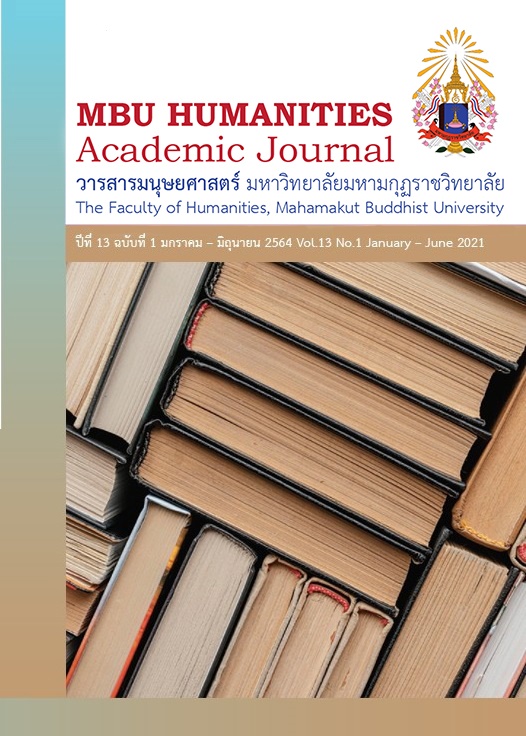A Study of the Relationship between Karma and Resolution for Being Appreciated a Specialist of Civilized Person in Theravada Buddhism
Main Article Content
Abstract
This thesis is a documentary research. With the objective of 1) to study the merit of karma in Theravada Buddhism; 2) to study the obtaining of attitudes of monks in Theravada Buddhism; 3) to study patterns and the category of charity and attentiveness of the noble people in Theravada Buddhism.
The results of the research were as follows: Buddhist karma refers to actions performed with intent. It is based on passion and expresses the physical, verbal and emotional well and bad karma. Such a noble person is a great person who attains Dharma in Buddhism. It consists of four types of people: Phra Singthat, Sakthakami, Anakami, and Arhat Ettakha, referring to the position of the one who has been regarded by God as an excellence in any particular area Setting in this doctrine It can be due to 4 reasons: 1) with the incident 2) by coming 3) with a skilled person 4) with a great person with you Some of the Thera monks have the position of Ettakka for one reason. Some images can be for 2 reasons, some can be for 3 reasons, some can be for all 4 reasons. The word "pray" in Buddhism Which in Buddhism means determination, unshakable In order to promote the collection of charity, which is the wish of self-esteem to excellence in various aspects of Buddhism. Was regarded by the Lord Buddha as an ethical, which is the ultimate goal that has been determined The deeds of the excellent Phra Ariyachon, who was appointed by the Master Each of you in the past life has accumulated countless. Which has a pattern to create charity in some ways that are different. Forms and categories of charity and attitudes of monks in Theravada Buddhism Divided into the creation of various types of charity, which is absolutely with alms as the basis for all karma That charity must be done continuously. When accumulating enough in the habit of ascension A charitable mind leads to the best in both this world and the next, to the attainment of the highest divine Dharma. When accumulating enough in the habit of ascension A charitable mind leads to the best in both this world and the next, to the attainment of the highest divine Dharma. When accumulating enough in the habit of ascension A charitable mind leads to the best in both this world and the next, to the attainment of the highest divine Dharma. Forms and categories of charity and attitudes of monks in Theravada Buddhism Divided into the creation of various types of charity, which is absolutely with alms as the basis for all karma That charity must be done continuously.
When accumulating enough in the habit of ascension A charitable mind leads to the best in both this world and the next, to the attainment of the highest divine Dharma. Forms and categories of charity and attitudes of monks in Theravada Buddhism Divided into the creation of various types of charity, which is absolutely with alms as the basis for all karma That charity must be done continuously. When accumulating enough in the habit of ascension A charitable mind leads to the best in both this world and the next, to the attainment of the highest divine Dharma.
Karma is an intentional charity that has been done in the past. As a result, it has been regarded as the "Attitude" of the Holy Man in Buddhism. Which is exemplified by Ettak, who was regarded as the best in the past by all Buddhas. All of you have to create great charity in various fields until you get the approval of the King. To succeed in being able to teach, you must practice good deeds and earnestly desire in that area. With the merit of karma, it would also be able to achieve the attitudes in Buddhism in this way.
Article Details
References
เทพรัตนราชสุดาฯ สยามบรมราชกุมารี, สมเด็จพระ. (2534). ทศบารมีในพระพุทธศาสนาเถรวาท. กรุงเทพฯ: โรงพิมพ์มหามกุฏราชวิทยาลัย.
นฤมล มารคแมน. (2541). มนุษย์และความเป็นจริงของชีวิตในทัศนะของพระพุทธศาสนา. กรุงเทพฯ: มหาวิทยาลัยรามคําแหง.
บรรจบ บรรณรุจิ. (2544). อสีติมหาสาวก. กรุงเทพฯ: โรงพิมพ์มหาจุฬาลงกรณราชวิทยาลัย.
พระธรรมปิฎก (ป.อ. ปยุตฺโต). (2543). พจนานุกรมพุทธศาสน์ ฉบับประมวลศัพท์. กรุงเทพฯ: มหาจุฬาลงกรณราชวิทยาลัย.
พระธรรมปิฎก (ป.อ. ปยุตฺโต). (2543). พจนานุกรมพุทธศาสน์ ฉบับประมวลธรรม. กรุงเทพฯ: มหาจุฬาลงกรณราชวิทยาลัย.
มหาจุฬาลงกรณราชวิทยาลัย. (2539). พระไตรปิฎกภาษาไทยฉบับมหาจุฬาลงกรณราชวิทยาลัย. กรุงเทพฯ: โรงพิมพ์มหาจุฬาลงกรณราชวิทยาลัย.


